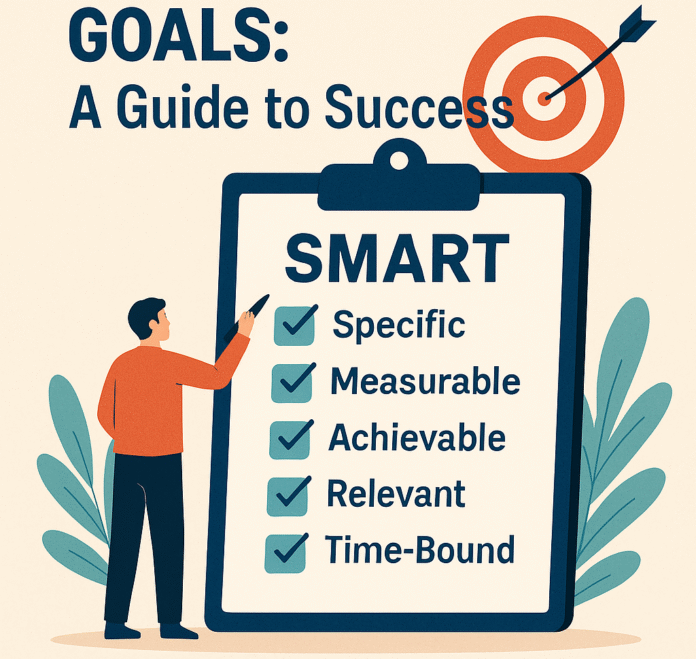Unlock Your Potential: The Definitive Guide to SMART Goal Setting
The best thing you can do for your personal and professional success is to set goals that are both significant and doable. People say things like “I want to get fit,” “I need to save money,” or “I’ll learn a new skill,” but they don’t always do what they claim they will. The SMART framework helps you make strategies that are clear, attainable, and effective out of vague aims. This thorough guide has all the information you need about SMART goal-setting, such as the most recent research, expert viewpoints, and helpful tools to help you attain your maximum potential.
Why SMART Goals Are Necessary
You might become mad and work hard for no reason if you want something but don’t have a plan. Studies demonstrate that those who set down clear, realistic goals are considerably more likely to attain them than people who don’t. Here are some of the benefits of SMART goals:
- Clarity and focus: When you know exactly what you want, it clears up any confusion and makes it easier to make a choice.
- Measurable Progress: Keeping track of your metrics keeps you going and lets you change your thinking when you need to.
- Responsibility: It’s simpler to hold yourself or your team accountable when there are defined rules and deadlines.
- More Motivation: Small wins keep you going and help you stick to your excellent habits.
- Better use of resources: Knowing what success looks like will help you plan how to use your time, energy, and money more wisely.
“Goals give us the motivation to keep going.” — Edwin A. Locke, a psychologist who looks at how groups work
Getting to Know the SMART Framework
What is SMART stand for?
- Specific
- Measurable
- Achievable
- Relevant
- Time-bound
Each section is highly important:
1. Very clear
You need to be extremely clear about what you want to do. Find out who is participating, what you want to do, where, when, and why.
❌ Not clear: “I want to get better at marketing.”
✅ Clear: “I will finish an online digital marketing certification through HubSpot Academy by December 31, 2025, to make it easier for me to get leads for my small business.”
2. Can be measured
Keep track of how far you’ve come by using certain metrics or criteria. This helps you remember how far you’ve come and when you’ve attained your goal.
❌ Not measurable: “I want to read more books.”
✅ Measurable: “Every month this year, I will read one business book and write down what I learn in a reading journal. That’s 12 books in all.”
3. Maybe
Your objective should be demanding but still possible with the time and equipment you have.
❌ Not realistic: “I’ll make three times as much money freelancing in a month.”
✅ Achievable: “I will pitch to five new clients every week for the next three months and make 20% more money as a freelancer.”
4. Very crucial
Make sure that your long-term goals, values, and plans all work together. If you have a goal that is essential to you, you can make meaningful progress.
❌ Not helpful: “I’ll learn to play the cello” if you want to get forward in your coding job.
✅ Relevant: “I’ll learn how to automate things in Python to make our team’s reporting process better. This will cut down on manual work by half.”
5. Short on time
Make things urgent by setting a specific due date and stop putting things off for good.
❌ Not time-bound: “I’ll work out someday,” with no due date.
✅ Time-bound: “I will work out for 30 minutes, five days a week, for the next eight weeks, starting on August 1, 2025.”
A Guide to Brainstorming Your SMART Goals in Steps
- Make a list of everything you want to get better at, such your job, your health, your money, your relationships, and your own growth.
- Don’t be afraid to write down anything you think.
- Write down what is most important to you.
- Check each aim to determine how likely it is to happen and how much it will change things.
- Use an Impact vs. Effort Matrix to put them in order.
- Tell us the details
- Follow the SMART criteria and make sure your goal statements for the most critical tasks are clear.
- Find out what it means to be successful
- Set “Measurable” standards in terms of numbers.
- “Finish 10 client projects by the end of Q4,” for example. “Save $5,000” and “Lose 10 pounds.”
- Look at what you have and what you can’t do.
- Write down the skills, time, money, and people you need to help you.
- Make your goals more realistic so you can attain them.
- Make Deadlines
- Set goals for each month or week to assist you attain your long-term goals.
- Use Trello or Asana, which are two online calendars or applications for managing projects.
- Plan ahead
- Make a plan for how to reach each goal.
- Set aside some time every day to get a particular number of things done.
- Change and Look
- Check in with each other on a regular basis, say once a week or once a month.
- Use applications or dashboards that keep track of your habits to see how far you’ve come.
- Remember Important Events
- When you reach your sub-goals, give yourself a treat.
- People feel better and keep continuing when they get positive feedback.
How to Set SMART Goals
| What kind of aim do you have? | A SMART Goal in Action |
| “By November 30, 2025, I need to pass the test and finish 35 hours of training to get my PMP certification.” | Specific: PMP certification, 35 hours training. Measurable: Pass test, 35 hours. Achievable: With dedicated study. Relevant: Career advancement. Time-bound: November 30, 2025. |
| “Train four times a week so you can finish a 5K race in less than 30 minutes by October 1, 2025.” | Specific: 5K race, less than 30 minutes. Measurable: Race time. Achievable: With 4x/week training. Relevant: Fitness goal. Time-bound: October 1, 2025. |
| “Save $200 a month so that by July 31, 2026, you have $2,400 in an emergency fund.” | Specific: $2,400 emergency fund. Measurable: $200/month. Achievable: With budgeting. Relevant: Financial security. Time-bound: July 31, 2026. |
| “You should have finished an intermediate Spanish course on Duolingo (level 25) by December 31, 2025.” | Specific: Intermediate Spanish, Duolingo Level 25. Measurable: Level 25. Achievable: Consistent practice. Relevant: Language learning. Time-bound: December 31, 2025. |
Using Digital Technologies and Resources to Their Fullest
- Habit-Tracking Apps: Done, Streaks, and Habitica.
- You can keep track of your projects with Trello, Asana, and ClickUp.
- Passion Planner and Panda Planner are two planners and goal journals.
- Two sorts of accountability groups are mastermind groups and accountability pals.
- Two tools that can help you see things more clearly are mind maps (MindMeister) and vision boards (Canva).
- Set up calendar notifications or specific apps to help you remain on track.
Setting Goals That Are Too High Is a Common Mistake That Can Be Fixed.
| Mistake | Solution |
| Too many goals | Break major goals down into smaller ones and check the deadlines again. |
| No one is to blame. | Tell everyone what you want to do or locate someone to help you stay on track. |
| Bad metrics | Use measurements that genuinely reflect progress, such quality over quantity, as a solution. |
| Plans that can’t be amended | Plan for additional time and look over your quarters so you may adjust your plans if your priorities change. |
| Not Taking Care of Yourself | Make sure you plan days off and check-ins for your mental health into your routine. |
Implementation Intentions: Advanced Plans for Long-Term Success
- Make plans like “If it’s 6 PM, I’ll run for 30 minutes.”
- Public Commitment: Tell your friends what you plan to do or share your aspirations on social media.
- When you stack habits, you add new ones to the things you perform every day. You could, for example, meditate for five minutes after your morning coffee.
- Changing the way you think: Write in a journal and tell yourself good things that help you improve.
Sarah, the Marketing Manager, Is a Genuine Person Who Works for the Company.
There are too many requests to start a new product.
SMART Goal: “By publishing two gated content offers each month and running a a $500 Facebook ad campaign, we want to grow the email list by 25% (from 8,000 to 10,000 subscribers) in three months.”
The list expanded by 28% in 12 weeks, the conversion rate went up by 15%, and the ads made four times as much money as they cost.
Worksheets and Examples
- Worksheet for SMART Goals
- The columns are Specific, Measurable, Achievable, Relevant, and Time-bound.
- A plan for weekly check-ins
- Parts: Wins, Problems, and What to Do Next
- Monthly Progress Dashboard
- Use charts to keep track of things like how much money you have saved, how many projects you have done, and how much weight you have lost.
In Conclusion
SMART goals help you make plans by making things clear, keeping you on track, and providing you energy. This helps you reach your goals. The SMART framework is a proven technique to help you reach your goals, whether they are to improve yourself, get forward in your job, or make better choices for your health. Make a SMART goal, figure out how to reach it, and celebrate each step along the way. You will be pleased you did this in the future.
Many People Want to Know These Things.
After you set your SMART goals, can you adjust them? Yes. You should check your goals every three months to determine whether they need to be updated because you learned something new or because you want to accomplish something else. Change the “Achievable” and “Time-bound” parts if you need to.
What will happen if I don’t make the deadline? Find out what triggered the problem, whether it was scope creep, not having enough resources, or something else that came up out of the blue. Next, set new, more realistic deadlines. Instead of giving up on your objective, learn from your mistakes.
How many SMART goals should I establish at the same time? To stay on track and not become too stressed out, set only one to three large goals for each quarter.
Can teams set SMART goals? Yes, of course. In project management, SMART goals assist everyone on the team stay on the same page, know what their role is, and keep track of how far they’ve come.
Do SMART goals stop individuals from being creative? Not if you make room for change. Follow SMART, but don’t be scared to mix things up and try new things.
How can I know how I’m doing? Use dashboards, habit-tracking applications, or basic spreadsheets with colored status indicators to keep track of your progress.
What if I want to learn how to talk to people better? Set goals that you can track, like “Finish three public speaking events” or “Get feedback from your peers once a month.”
Are SMART goals useful for kids? Yes. Set age-appropriate goals, such “Read for 20 minutes every day for a month,” and use simple phrases.
How long should it take to achieve your SMART goals? How long it takes depends on how hard it is. You can choose between short-term (1 to 3 months), mid-term (6 to 12 months), or long-term (1 to 3 years).
How essential is your mindset? A growth attitude keeps you going. Set SMART objectives and employ affirmations and your thoughts to get stronger.
References
- Doran, G. T. (1981). There’s a S.M.A.R.T. way to write management’s goals and objectives. Management Review.
https://www.pearsonhighered.com/images/samplechapter/0138047360.pdf - Locke, E. A., & Latham, G. P. (2002). Building a practically useful theory of goal setting and task motivation. American Psychologist, 57(9), 705–717.
https://doi.org/10.1037/0003-066X.57.9.705 - MindTools. SMART Goals – How to Make Your Goals Achievable.
https://www.mindtools.com/pages/article/smart-goals.htm - HubSpot Academy. Digital Marketing Certification Course.
https://academy.hubspot.com/courses/digital-marketing - Harvard Business Review. Why You Need to Have Both Stretch and SMART Goals.
https://hbr.org/2023/03/why-you-need-to-have-both-stretch-and-smart-goals




































